ASUS MYPAL 632, MYPAL A636 User Manual

MyPal A636/632
Handbook

E1810
First edition V1
July 2005
Copyright © 2005 ASUSTeK COMPUTER INC. All Rights Reserved.
No part of this manual, including the products and software described in it, may be reproduced, transmitted, transcribed, stored in a retrieval system, or translated into any language in any form or by any means, except documentation kept by the purchaser for backup purposes, without the express written permission of ASUSTeK COMPUTER INC. (“ASUS”).
Product warranty or service will not be extended if: (1) the product is repaired, modified or altered, unless such repair, modification of alteration is authorized in writing by ASUS; or (2) the serial number of the product is defaced or missing.
ASUS PROVIDES THIS MANUAL “AS IS” WITHOUT WARRANTY OF ANY KIND, EITHER EXPRESS OR IMPLIED, INCLUDING BUT NOT LIMITED TO THE IMPLIED WARRANTIES OR CONDITIONS OF MERCHANTABILITY OR FITNESS FOR A PARTICULAR PURPOSE. IN NO EVENT SHALL ASUS, ITS DIRECTORS, OFFICERS, EMPLOYEES OR AGENTS BE LIABLE FOR ANY INDIRECT, SPECIAL, INCIDENTAL, OR CONSEQUENTIAL DAMAGES (INCLUDING DAMAGES FOR LOSS OF PROFITS, LOSS OF BUSINESS, LOSS OF USE OR DATA, INTERRUPTION OF BUSINESS AND THE LIKE), EVEN IF ASUS HAS BEEN ADVISED OF THE POSSIBILITY OF SUCH DAMAGES ARISING FROM ANY DEFECT OR ERROR IN THIS MANUAL OR PRODUCT.
SPECIFICATIONS AND INFORMATION CONTAINED IN THIS MANUAL ARE FURNISHED FOR INFORMATIONAL USE ONLY, AND ARE SUBJECT TO CHANGE AT ANY TIME WITHOUT NOTICE, AND SHOULD NOT BE CONSTRUED AS A COMMITMENT BY ASUS. ASUS ASSUMES NO RESPONSIBILITY OR LIABILITY FOR ANY ERRORS OR INACCURACIES THAT MAY APPEAR IN THIS MANUAL, INCLUDING THE PRODUCTS AND SOFTWARE DESCRIBED IN IT.
Microsoft, Activesync, Outlook, Pocket Outlook, Windows, and the Windows logo are either registered trademarks or trademarks of Microsoft Corporation in the United States and/or in other countries. Microsoft products are licensed to OEMs by Microsoft Lincensing, Inc., a wholly owned subsidiary of Microsoft Corporation.
ii

Contents at a glance
This handbook contains the information you need to efficiently use ASUS® MyPal A636/632 Pocket PC.
• Chapter 1 - Get started! ............................................. |
1-1 |
This chapter introduces the ASUS MyPal A636/632 Pocket PC, how to set and power it up, and basic screens that will familiarize you with its many features.
• Chapter 2 - Learn the basics ..................................... |
2-1 |
This chapter will teach you the basic functions in MyPal A636/ 632. You will learn how to enter, find, and organize information, customize the device, and use the bundled simple applications.
• Chapter 3 - Synchronize and enhance ..................... |
3-1 |
This chapter tells you how to use the Microsoft® ActiveSync® to synchronize your device with your desktop computer. To further enhance your device, refer to the instructions on how to install other applications from the Companion CD.
• Chapter 5 - Microsoft® Pocket Outlook ..................... |
5-1 |
This chapter details the procedures for the Microsoft® Pocket Outlook Calendar, Contacts, Tasks, Notes, and Messaging.
• Chapter 6 - Companion programs ............................ |
6-1 |
This chapter includes information on Pocket Word, Pocket Excel, MSN Messenger, and Windows Media Player for Pocket PC.
• Chapter 7 - Pocket Internet Explorer ........................ |
7-1 |
This chapter gives information on using Pocket Internet Explorer, Mobile Favorites folder, and AvantGo interactive service.
iii

• Chapter 8 - Get connected ........................................ |
8-1 |
This chapter provides the procedures for connecting to the Internet, and for transferring data using infrared (IR).
• Chapter 9 - Bluetooth® ........................................................................ |
9-1 |
This chapter provides information on using the Bluetooth feature built-in the device.
• Chapter 10 - Using Wi-Fi® ............................................................. |
10-1 |
This chapter provides information on using the Wi-Fi® feature built-in the device.
• Appendix - Notices ................................................... |
A-1 |
This part includes the safety notices and regulations.
iv

MyPal A636/632 specifications
|
Processor |
Intel® XScale™ PXA272 416MHz |
|
Operating |
Microsoft® Windows Mobile™ 5.0 |
|
system |
|
|
Memory |
|
|
128MB Flash ROM |
|
|
|
64MB SDRAM (107MB user accessible) |
|
Display |
|
|
3.5-inch, brilliant transflective TFT LCD |
|
|
|
65,000 Full-color, 16-bit display |
|
|
QVGA, 240x320 resolution with Touch Pad |
|
|
|
|
Battery |
1300 mAh removable/rechargeable (A636) |
|
|
removable (A632) Li-ion battery |
|
|
|
|
Expansion slot |
One slot (A636) SD card slot (SDIO/SD/ |
|
|
MMC) Dual slot (A632) SD card slot (SDIO/ |
|
|
SD/MMC) and mini SD |
|
|
|
|
Communication |
WLAN 802.11b (A636) ; USB 1.1 ; |
|
|
Wi Fi® ; Bluetooth® v1.2 (A632 factory |
|
|
option) ; Infrared 115.2 Kbps |
|
Audio |
|
|
3.5 mm stereo |
|
|
Size |
|
|
122 mm x 73.2 mm x 18.65 mm (L x W x H) |
|
|
Weight |
|
|
175 grams (with battery) |
|
|
|
|
v
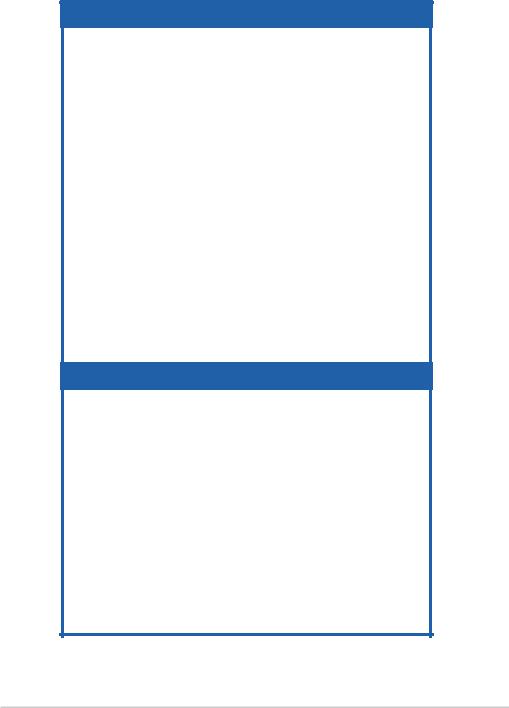
Package contents
Your package includes several accessories for the Pocket PC. After unpacking, check the items against the list below and make sure that they are in good condition. If any item is missing or damaged, contact your dealer or retailer immediately.
Standard items
•ASUS MyPal A636/632
•Cradle
•USB sync cable
•AC adapter/power cable
Input |
: |
100V ~ 240V |
Output |
: |
5V 2.4A 10W |
•1100 mAh Lithium Ion battery
•Stylus
•Protection case
•Microsoft® Companion CD
•Bonus CD
•Handbook
•Quick Start Guide
•Warranty card
Optional accessories
•Stylus
•Car charger
•Leather protection case
•Traveling USB sync cable
•Traveling USB host cable
•Traveling serial cable
•AC adapter/power cable (UL/CEE/UK/SAA/CCEE)
•GPS solution kit
•Bluetooth® GPS solution kit
•Extension battery (1800 mAh)
vi

Chapter 1
Get started!
♦ Introducing MyPal ................................................ |
1-2 |
Front features ........................................................................... |
1-2 |
Back features ........................................................................... |
1-3 |
Side features ............................................................................ |
1-4 |
Top features ............................................................................. |
1-5 |
Bottom features ........................................................................ |
1-5 |
The stylus ................................................................................. |
1-6 |
GPS car mount kit .................................................................... |
1-6 |
♦ Setting up MyPal................................................... |
1-7 |
Installing and removing the battery .......................................... |
1-7 |
Connecting a power source ..................................................... |
1-8 |
Setting up GPS ........................................................................ |
1-9 |
♦ |
Additional storage .............................................. |
1-10 |
|
Installing and removing SD/MMC/SDIO card ......................... |
1-10 |
|
Installing and removing mini SD card (A632 only) ................. |
1-10 |
♦ |
Activating MyPal .................................................. |
1-11 |
♦ Basic screens on MyPal..................................... |
1-12 |
|
|
Today screen .......................................................................... |
1-12 |
|
Menu bar ................................................................................ |
1-12 |
|
Start menu ............................................................................. |
1-13 |
|
Pop-up menus ........................................................................ |
1-13 |
Get started! |
1-1 |
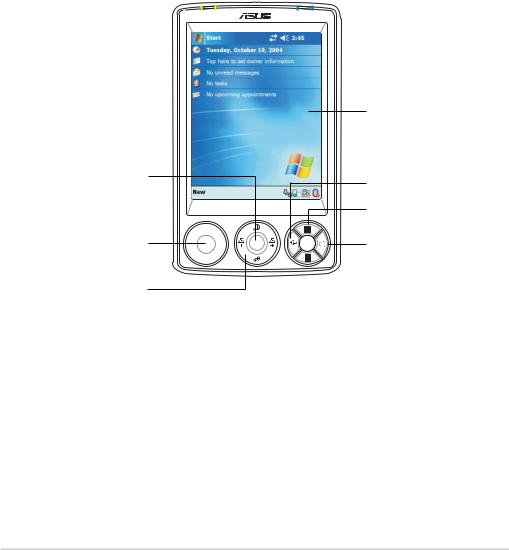
Introducing MyPal
The ASUS® MyPal A636/A632 is truly a good companion wherever you go. Powered by a 416MHz Intel® XScale PXA272 processor, equipped with
64MB SDRAM and 128MB Flash ROM, and bundled with the Microsoft®
Windows Mobile® 5.0 plus a host of useful utilities, you have everything you need in your pocket!
MyPal A636 comes with additional Wi-Fi feature that allows you to connect to wireless LAN and Internet. MyPal A636 has a single SD card slot, whereas MyPal A632 comes with dual slots: SD and mini SD slots.
Front features
Power LED |
Bluetooth/Wi-Fi LED |
||||||
|
|
|
|
|
|
|
|
Launch button
Speaker
4-way Navigaition
button
LCD touch screen
Notes button |
Calendar button |
Mode Switcher button |
 Contacts button
Contacts button
•Power LED - shows a steady red light when the battery is charging; steady green when the battery is fully charged and the device is connected to an AC power source.
•Bluetooth/GPS/Wi-Fi LED - lights up blue when the Bluetooth® feature is on (MyPal A636 only); lights up yellow green when GPS is on; lights up red when Wi-Fi is on (MyPal A636 only).
•LCD touch screen - allows you to enter, read, send, receive or edit data by tapping on it. The screen lumination is increased or decreased by changing the backlight settings.
1-2 |
Chapter 1 |
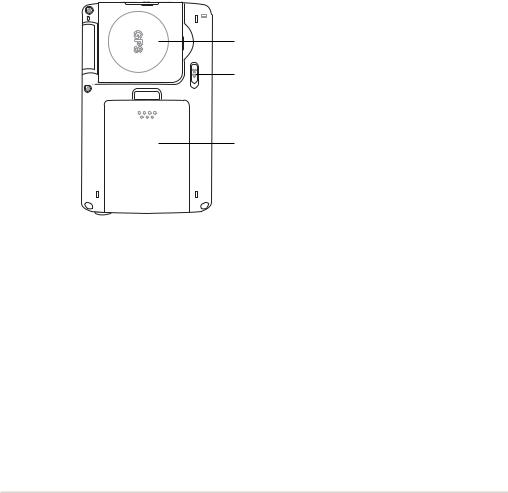
•Speaker - allows you to hear alarms and other sound outputs from the device.
•4-way navigation button - functions like the four arrow keys on a keyboard. This button allows you to move through the program icons, folders, or files in a menu by scrolling up or down, left or right.
•Launch button - functions like the enter/return key on a keyboard. Press once to launch a selected program, list folders contents, or open a file.
•Contacts button - opens your contacts list at any tiime.
•Calendar button - opens the Calendar program at any time.
•Mode Switcher button - allows you to switch between Today, Windows media and Rotate screen.
•Notes button - opens the Notes program at any time.
Back features
 Stylus
Stylus
GPS antenna
Hold latch
HOLD
Battery cover
•Stylus - used for tapping or writing on the LCD touch screen.
•GPS antenna - used as a signal receiver that pinpoints your exact location. This information is retrieved from satellites. Flip open this panel when using the GPS. If signal reception is not strong enough, you can connect an external antenna to the socket on the top side of this panel.
•Battery cover - provides protection to the battery compartment of the device.
Get started! |
1-3 |
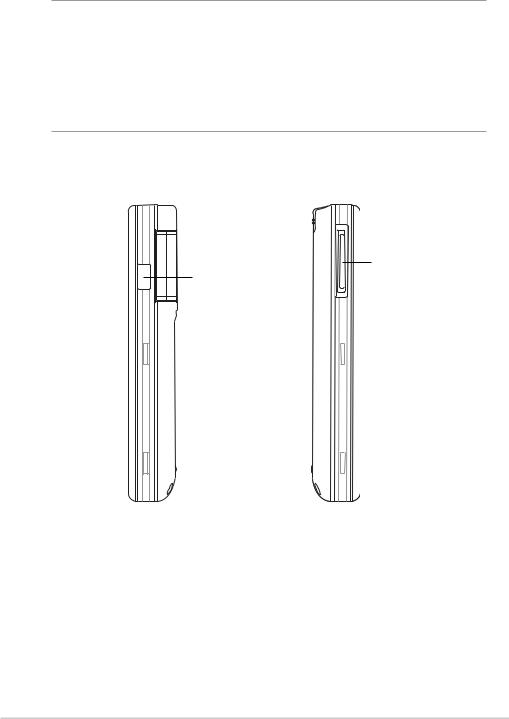
•Hold - provides a safety measure to avoid users from accidentally tapping the screen or turning on the device. Move the switch towards the word Hold to turn off the screen and prevent it from turning back on even when you tap the screen or press a button. Move the switch towards the opposite direction to disable this feature.
NOTES As a precaution, the Power button is automatically disabled when you remove the Back cover. You can only turn on the power when the back cover is installed to the unit.
The Back cover is removable, and allows you to remove or replace the main battery. Refer to section “Setting up MyPal” on page 1-7 for instructions.
Side features
|
Mini SD card slot |
Infrared (IR) Port |
(MyPal A632 only) |
•Infrared (IR) port - allows you to copy or send data to another device with an IR port. For a successful exchange of data, the IR port of both devices must be properly aligned and facing each other within the IR communication range.
•Mini SD slot (A632 only) - accommodates a mini SD memory card.
1-4 |
Chapter 1 |
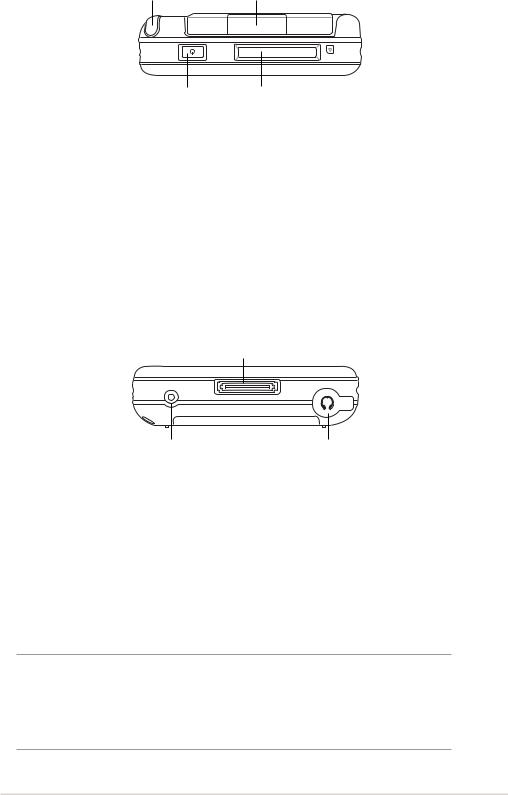
Top features
Stylus |
External antenna cover |
SD
Power button |
SD card slot |
|
(SD/SDIO/MMC) |
•External antenna cover - covers the external antenna port. If the GPS signal is weak, connect an external antenna to the port.
•SD card slot - accommodates an SD memory card, MMC memory card or an SDIO interface card (e.g. 802.11b, camera, barcode scanner, etc.)
•Power/Backlight button - turns the device power on or off if you press the button quickly. Press and hold the button for a few seconds to turn the backlight on or off. Turning off the backlight saves battery power.
Bottom features
Sync and power cable connector
RESET
Reset switch Headphone jack
•Headphone port - connects a headphone.
•Sync and power cable connector - connects to the 26-pin female connector on the cradle. If you are not using the cradle, connect the 26pin USB sync cable directly to this connector to synchronize your device with your computer.
•Reset switch - allows you to perform a soft reset in case the device malfunctions, or when an application hangs. Press the tip of the stylus on this switch to reset the system.
NOTE To perform a hard reset, press and hold the power button while you press the tip of the stylus on the reset switch. A hard reset restores the original configuration of your device and erases all data. Back up your data before performing a hard reset!
Get started! |
1-5 |
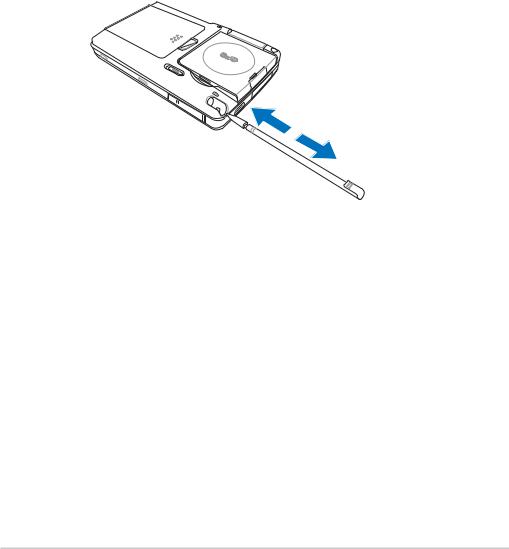
The stylus
The stylus functions on a Pocket PC the same way a mouse functions on a standard PC. Use the stylus to tap or drag on the LCD touch screen to open programs or execute commands.
•Tap. Touch the screen once with the stylus to open programs and select options.
•Drag. Hold the stylus on the screen and drag across the screen to select text and images. Drag in a list to select multiple items.
•Tap and hold. Tap and hold the stylus on an item to see a list of actions available for that item. From the pop-up menu, tap the action that you wish to perform.
D |
HO |
L |
SD |
ni |
|
|
|
m |
i |
|
|
|
|
To remove the stylus, slide it out from the compartment.
To store the stylus, slide it back into the compartment.
The GPS car-mount kit
The GPS car-mount kit includes:
•GPS cradle - holds and securely attaches the device to the car’s windshield.
•Car power cord - supplies DC power the device through the car lighter socket.
1-6 |
Chapter 1 |
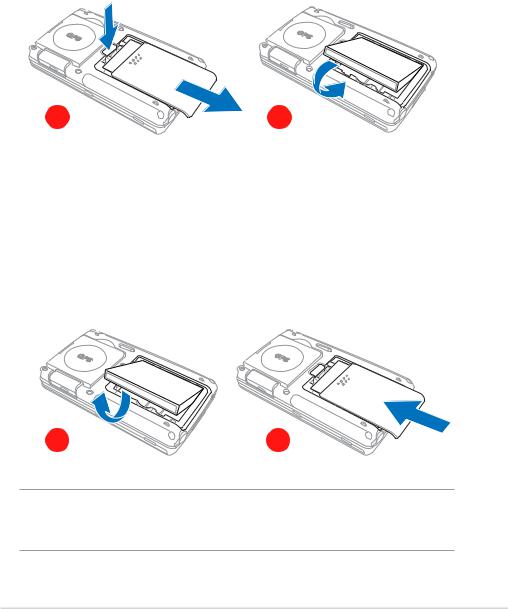
Setting up MyPal
Installing and removing the battery
1.First, remove the battery cover. Press on the battery cover latch behind the device, then slide down the battery cover to remove it.
2.Position and insert the right side of the battery with its contacts matching the 4-pin connector on the right side of the compartment. Then press the left side of the battery to completely fit into the compartment.
HOLD
HOLD
1 |
2 |
3.To remove, flip up the left edge of the battery to remove it from the compartment.
4.Place the battery cover on top of the opening at the back of the device making sure that the 4 notches match the 4 notches on the device. Then slide the battery over upward until you hear a click. When you hear the click, this means that the battery cover is securely locked into place.
HOLD |
HOLD |
3 |
4 |
NOTE As a precaution, the power button is automatically disabled when you remove the battery cover. The device cannot be turned on while the battery cover is still detached.
Get started! |
1-7 |
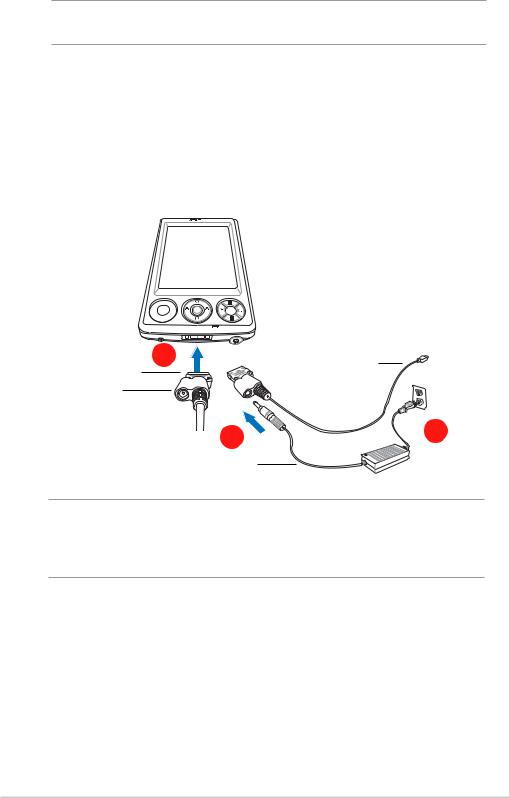
Connecting to a power source
IMPORTANT You need to charge the battery before using the device for the first time.
To connect the power adapter and charge the battery
1.Connect the power cable to the jack on the sync cable adapter.
2.Connect the 26-pin device plug of the sync cable to the 26-pin connector at the bottom of the device.
3.Connect the power plug to a grounded wall socket.
2 |
USB sync cable |
26-pin device plug
Sync cable adapter
1 |
3 |
|
AC adapter/ Power cable
NOTE As soon as the power cable is connected to a power source, the battery will start charging and the power LED will show a steady red light. See page 2-25 on how to display the battery power status.
1-8 |
Chapter 1 |
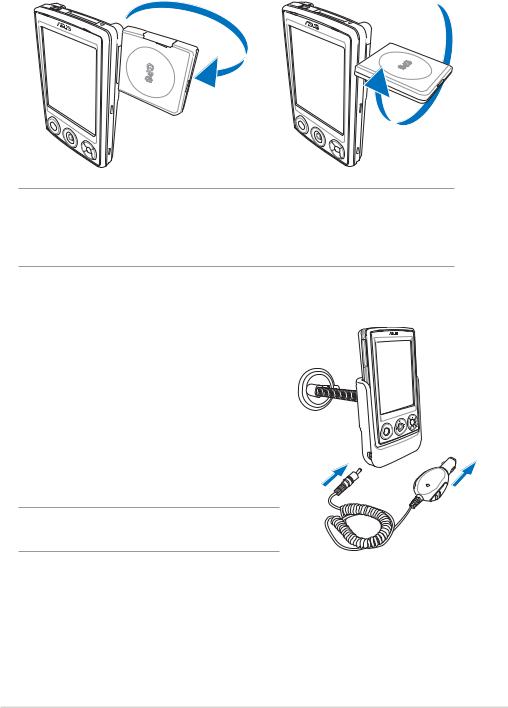
Setting up GPS
To receive GPS signal
Flip open the GPS antenna panel from the back of the device. You may rotate the panel as illustrated below.
SD
DS
NOTE If the GPS signal reception is weak, purchase and use an external antenna. Flip open the antenna cover that is above the panel, then plug in the external antenna to the antenna port.
To use the GPS car-mount kit
1. Mount the GPS cradle onto the car’s windshield, then place the device on the cradle.
2. Connect the car power cord to the power jack at the lower left side of the mount cradle.
3. Plug the other end of the car power cord to the cigarette lighter socket.
NOTE The GPS cradle can be freely rotated.
Get started! |
1-9 |
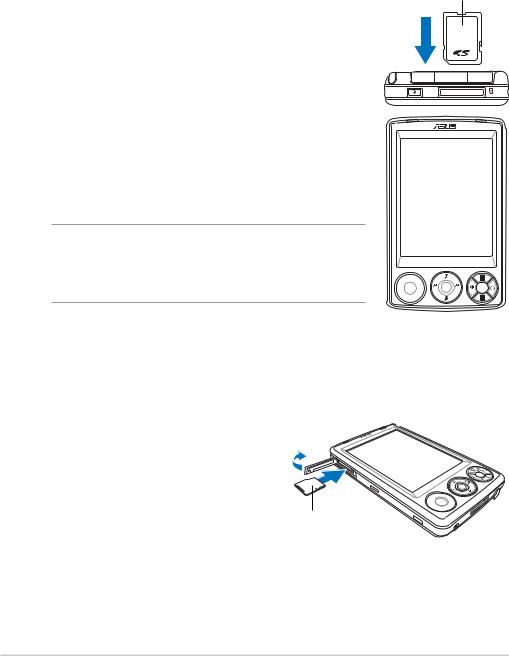
Additional storage
MyPal A636 comes with the standard SD card slot while MyPal A632 has an additional mini SD card slot . The SD card slot can be inserted with SD
(Secure Digital) or MMC memory cards. It also supports SDIO cards of various functionalities including 802.11b, camera, scanner, etc.
Installing and removing SD/MMC/SDIO card
1.With the label side (usually the side with the card manufacturer’s name) face up, and the barcode/ serial number side face down, insert the card into the SD card slot located on top of the device.
2.Push the card all the way into the slot until it fits completely. If properly installed, the SD or MMC card edge aligns with the top edge of the device.
SDIO cards usually have an extended part that protrudes over the slot edge.
3.To remove, press the card slightly until it ejects out. You may then safely remove the card.
NOTE An SD/MMC/SDIO/mini SD card fits only in one orientation, and slides smoothly into the slot if inserted correctly. DO NOT force the card into the slot!
Label
SD
Installing and removing mini SD card (for A632 only)
1. Flip open the mini SD card slot cover.
2. With the label side (usually the side with the card manufacturer’s name)
face up, and the barcode/serial number side face down, insert the card into the mini SD card slot
Label side
located on the left side of the device.
3.Push the card all the way into the slot until it fits completely.
4.To remove, press the card slightly until it ejects out. You may then safely remove the card.
1-10 |
Chapter 1 |
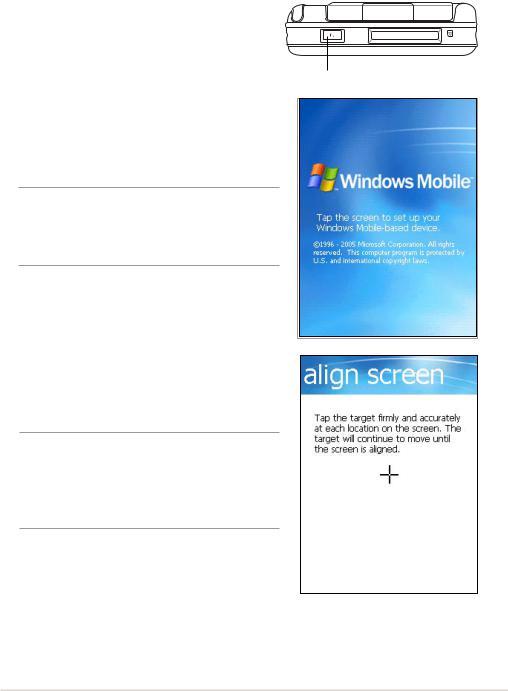
Activating MyPal
You need to properly calibrate and activate your device before using it.
This process ensures accurate positioning when entering text and selecting menus.
Calibrating and activating your device
1. Press the power button.
SD
Power button
2.The Welcome screen appears when you turn on the device for the first time, or after performing a hard reset. Tap anywwhere on the screen to continue.
NOTE To perform a hard reset, press and hold the power button while you press the tip of the stylus on the reset switch.
3.Tap the center of the cross to perform the align screen process. You may have to do this step a few times to properly calibrate.
NOTE To launch the Align Screen function at any time, tap  , tap
, tap
Settings, then the System tab. Tap the Screen icon, then the
Align Screen button.
4.Follow the succeeding on-screen instructions.
5.Tap anywhere on the Complete screen
when you are done with the alignment and settings. You are now ready to use your device.
Get started! |
1-11 |
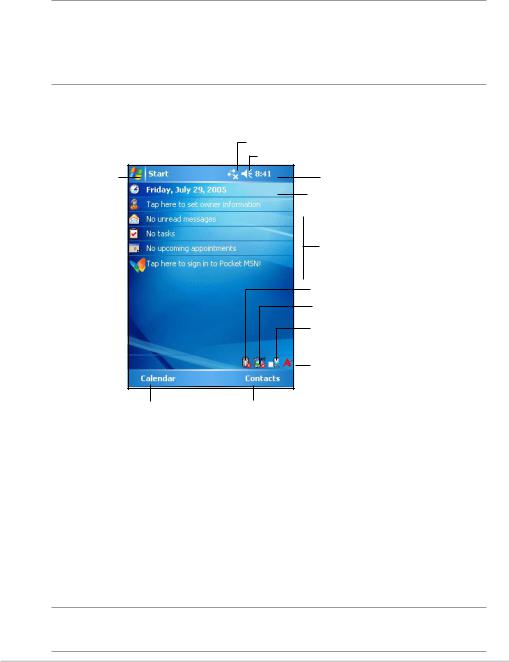
Basic screens on MyPal
Today screen
Normally, the Today screen appears when you turn on your device for the first time each day.
NOTE When the device is already on and the screen displays another program, you may return to the Today screen any
time by tapping the  icon. Then from the Start menu, tap
icon. Then from the Start menu, tap
Today.
As shown in the sample below, the Today screen lets you see at a glance the summary of the important information for the day.
Tap to open the start menu and to choose from the available programs
Tap to open the Calendar program
Tap to set up or change network or modem connections Tap to adjust the volume or mute all sounds
Tap to see the date, time, your next appointment, and the battery level
 Tap to change the date and time
Tap to change the date and time
Your day at a glance
Tap to display the Bluetooth® menu
Tap to display the Wi-Fi® menu (MyPal A636 only)
Tap to shift display to landscape or portrait orientation
Tap to open a menu where you can see common device status and settings (such as backlight setting, battery level, memory usage, and more)
Tap to open the Contacts program
From the Today screen, tap any of the listed items with the stylus to display the details. See “Chapter 2: Learn the basics” on how to modify the current tasks or activities, or to add new items or information.
Menu bar
At the bottom of the screen of a program is the Menu bar. You can use the menus and buttons on the Menu bar to perform tasks in programs.
NOTE The menus and buttons vary depending on the programs you are using.
1-12 |
Chapter 1 |
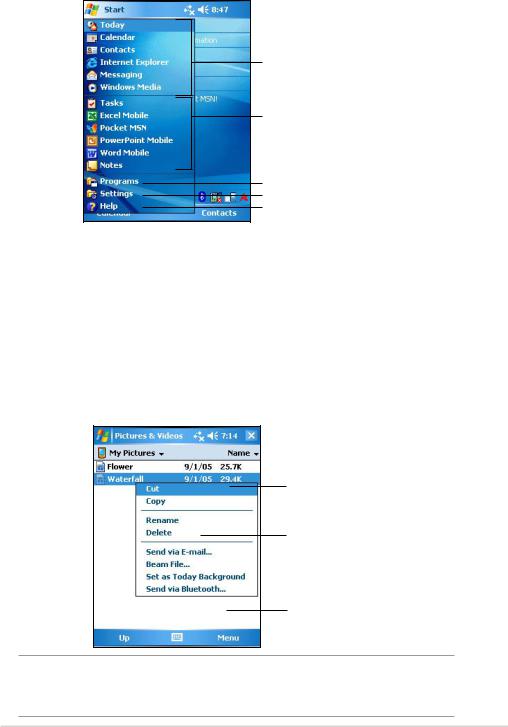
Start menu
From the Start menu, you can select programs, settings, and help topics.
To display the Start menu, tap the  icon from the top of the screen.
icon from the top of the screen.
Tap to open a program
Tap to open a recently used program
Tap to open the Programs menu
Tap to open the Settings menu
Tap to display the Help topics
Pop-up menus
With the pop-up menus, you can easily choose an action for an item. For example, you can use the pop-up menu in File Explorer to delete, copy, or beam an item.
To access a pop-up menu, tap and hold the stylus on the item that you wish to perform action on. When the menu appears, lift the stylus, and tap the action that you want to execute. To close the pop-up menu without performing an action, tap anywhere outside the menu.
Tap and hold until the pop-up menu appears
Tap the action that you wish to perform
Tap outside the pop-up menu to close it without performing an action
NOTE The pop-up menus are also available in most other programs on your device; however, the pop-up menu items vary depending on the program or application.
Get started! |
1-13 |

Pop-up menus
With the pop-up menus, you can easily choose an action for an item. For example, you can use the pop-up menu in File Explorer to delete, copy, or beam an item.
To access a pop-up menu, tap and hold the stylus on the item that you wish to perform action on. When the menu appears, lift the stylus, and tap the action that you want to execute. To close the pop-up menu without performing an action, tap anywhere outside the menu.
Tap outside the pop-up menu to close it without performing an action
Tap and hold until the pop-up menu appears
Tap the action that you wish to perform
NOTE The pop-up menus are also available in most other programs on your device; however, the pop-up menu items vary depending on the program or application.
Get started! |
1-17 |

Chapter 2
Learn the basics
♦ |
Viewing system information ................................ |
2-2 |
♦ |
Entering information ............................................ |
2-2 |
|
Entering text using the Input Panel .......................................... |
2-2 |
|
Writing on the screen ............................................................... |
2-6 |
|
Drawing on the screen ............................................................. |
2-8 |
|
Recording a message .............................................................. |
2-9 |
♦ Finding and organizing information ................. |
2-10 |
|
|
Using the Search function ...................................................... |
2-10 |
|
Using the File Explorer ............................................................ |
2-11 |
♦ |
Customizing your device .................................... |
2-11 |
|
Changing the date and time ................................................... |
2-12 |
|
Changing the Start menus ..................................................... |
2-12 |
|
Changing the owner information ............................................ |
2-13 |
|
Setting a password ................................................................ |
2-13 |
|
Changing the screen display orientation ................................ |
2-14 |
|
Changing the screen theme ................................................... |
2-16 |
|
Changing the button assignments ......................................... |
2-16 |
|
Setting the backlight ............................................................... |
2-17 |
|
Changing the battery power settings ..................................... |
2-18 |
|
Selecting sounds and notifications ......................................... |
2-19 |
|
Changing the audio settings .................................................. |
2-19 |
|
Changing the memory settings .............................................. |
2-21 |
♦ |
Using simple applications ................................. |
2-23 |
|
Calculator ............................................................................... |
2-23 |
|
Games ................................................................................... |
2-24 |
|
Pictures .................................................................................. |
2-26 |
|
Checking Device Status ......................................................... |
2-28 |
Learn the basics |
2-1 |

Viewing system information
Your device allows you to easily display the built-in specifications.
NOTE You can not change the information you see in the system information screens.
To display the system information:
1.Tap  > Settings > System tab > System Information icon
> Settings > System tab > System Information icon
2.To display the device specifications, tap Device Info tab. This will display various information such as the device ID, system memory, and wireless capabilities.
5. Tap the Version tab to view other information about the device.
Entering information
You can enter information in your device in any of the following ways:
•Use the input panel to enter text using the soft keyboard or the Letter Recognizer
•Write directly on the screen with the stylus
•Draw pictures on the screen
•Speak into the device microphone to record a message
•Use the Microsoft® ActiveSync® to synchronize or copy information from your desktop computer to your device
Entering text using the Input Panel
Use the Input Panel to enter information in any program on your device.
You can either type using the soft keyboard or write using the Letter Recognizer, Block Recognizer, or Transcriber. In either case, the characters appear as typed text on the screen.
To show or hide the input panel, tap the Input Panel button. Tap the arrow next to the Input Panel button to see your options.
2-2 |
Chapter 2 |
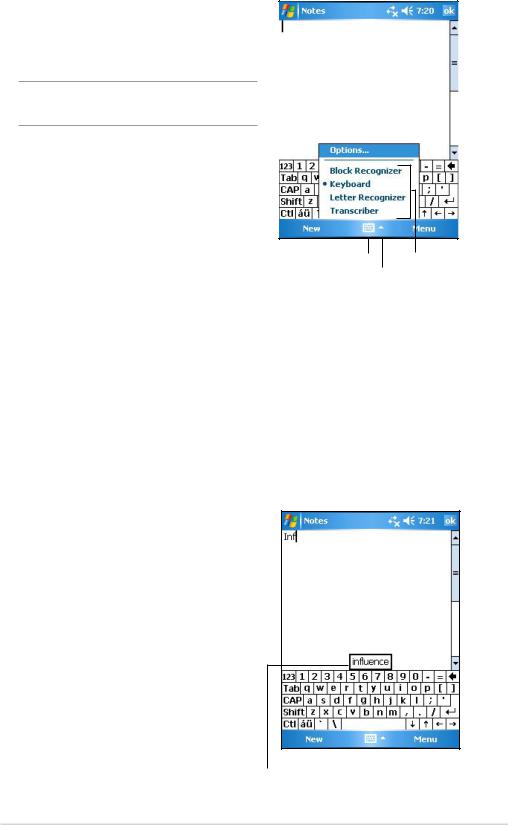
To type with the soft keyboard:
1.Tap the arrow next to the Input Panel button, then tap Keyboard.
NOTE For a demonstration, open Notes.
2.Tap the keys with the stylus to enter information.
Tap to show or hide the input panel Select an input method
Tap to display the input method options
Word completion feature
When you use the Input Panel and the soft keyboard, your device anticipates the word you are typing and displays it above the Input Panel.
When you tap the displayed word, it is inserted into your text at the insertion point. The more you use your device, the more words it learns to anticipate.
To change options on the word completion feature:
1. Tap  then tap Settings.
then tap Settings.
3. Tap Personal tab then tap Input.
5.Tap Word Completion tab.
6.Make your desired changes.
Tap here if this is the word you wish to use
Learn the basics |
2-3 |
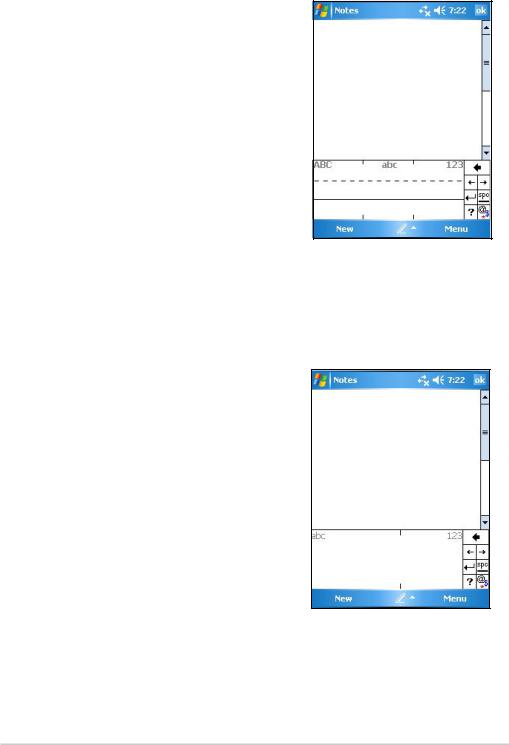
To use Letter Recognizer:
With the Letter Recognizer, you can write letters on the screen with the stylus as you would on paper.
1.Tap the arrow next to the Input Panel button, then tap Letter Recognizer.
2.Write a letter in the box.
When you write a letter, it is converted to a typed text that appears on the screen. For instructions and a demonstation on using the Letter Recognizer, tap the question mark next to the writing area.
To use Block Recognizer:
With the Block Recognizer, you can input character strokes that are similar to those used on other devices.
1.Tap the arrow next to the Input Panel button, then tap Block Recognizer.
2.Write a letter in the box.
When you write a letter, it is converted to a typed text that appears on the screen. For instructions and a demonstration on using the Block Recognizer, tap the question mark next to the writing area.
2-4 |
Chapter 2 |
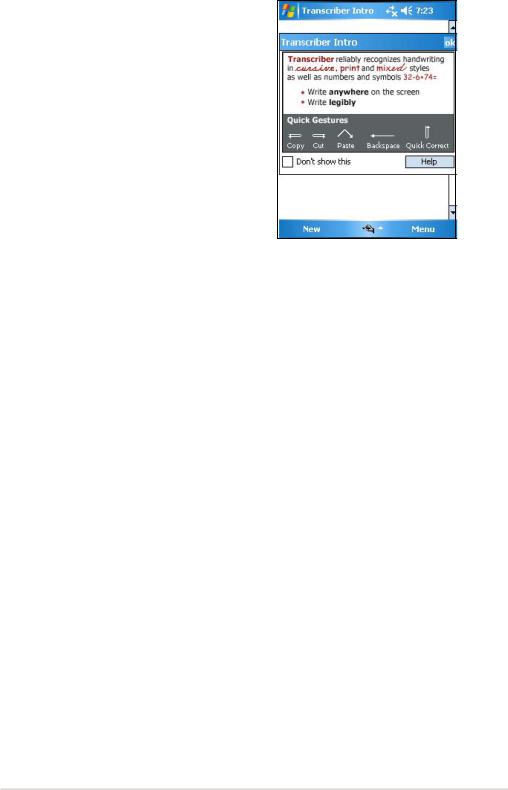
To use Transcriber:
With Transcriber, you can use the stylus to write anywhere on the screen as you would on paper. Unlike Letter Recognizer and Block Recognizer, you can write a sentence or additional information. Pause after writing and let
Transcriber convert the written characters to typed characters.
1.Tap the arrow next to the Input Panel button, then tap Transcriber.
2.Write anywhere on the screen.
For instructions and demonstration on using Transcriber, with Transcriber open, tap the question mark in the lower right corner of the screen.
To edit typed text:
1.Select the text that you wish to edit using either one of the following:
•drag the stylus over the text
•tap twice to select a word
•tap three times to select a paragraph
2.Tap Menu on the Menu bar and select an action, or use one of the tools in the Input Panel to enter a new text.
Learn the basics |
2-5 |
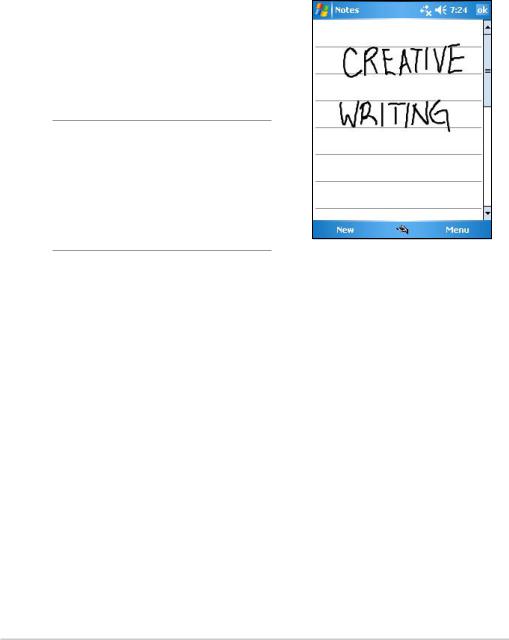
Writing on the screen
In any program that accepts writing, such as the Notes program, and in the Notes tab in Calendar, Contacts, and Tasks, you can use the stylus to write directly on the screen. Write the way you do on paper. You can edit and format what you have written and convert the writing to text at a later time.
To write on the screen:
1.Open the Notes program then tap
New on the Menu bar.
2.The screen displays a blank space with lines to help you write.
3.Write your text.
NOTE Some programs that accept writing may not have the Pen button. See the documentation for that program to find out how to switch to writing mode.
To edit your writing:
1.Tap and hold the stylus next to the text that you wish to select until the insertion point appears.
2.Without lifting, drag the stylus across the text to select it.
If you accidentally write on the screen, tap Menu, then Undo Ink and try again. You can also select text by tapping the Pen button to deselect it, then dragging the stylus across the screen.
3.Tap Menu on the Menu bar then select an action, or use one of the tools in the Input Panel to enter a new text.
To convert writing to text:
•Tap Menu on the Menu bar then tap Tools > Recognize.
To select a zoom level:
•Tap Menu > Zoom . From the list, tap a zoom percentage.
2-6 |
Chapter 2 |
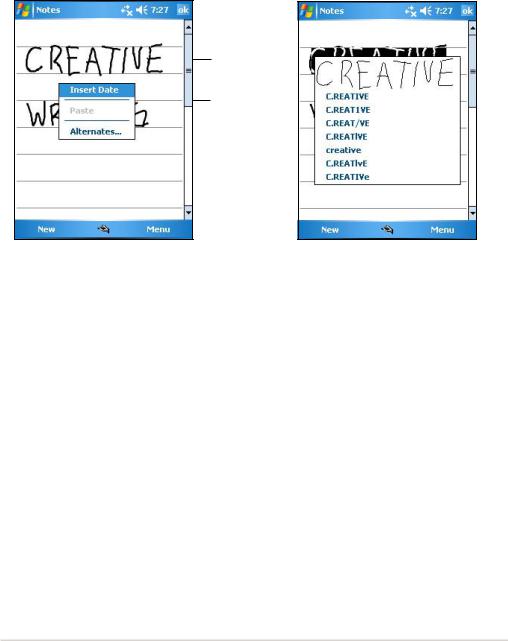
If the conversion is incorrect, you can select different words from a list of alternates or return to the original writing.
1.Tap and hold the incorrect word.
2.When the pop-up menu appears, tap Alternates to display a list of alternate words for the selection.
3.Tap the word that you want to use, or tap the writing at the top of the menu to return to the original writing.
Tap to return to your original writing
Or, tap the word that you want to use
Tips for getting good writing recognition
•Write neatly.
•Write on the line and draw descenders below the line. Write the cross of the “t” and apostrophes below the top line so that they are not confused with the word above. Write periods and commas above the line.
•For better recognition, try increasing the zoom level to 300% using the
Tools menu.
•Write the letters of a word closely and leave big gaps between words so that the device can easily tell where the words begin and end.
•Hyphenated words, foreign words that use special characters such as accents, and some punctuation cannot be converted.
•If you add writing to a word to change it after the word has been recognized, the writing that you added will be included when you try to recognize the writing again.
Learn the basics |
2-7 |
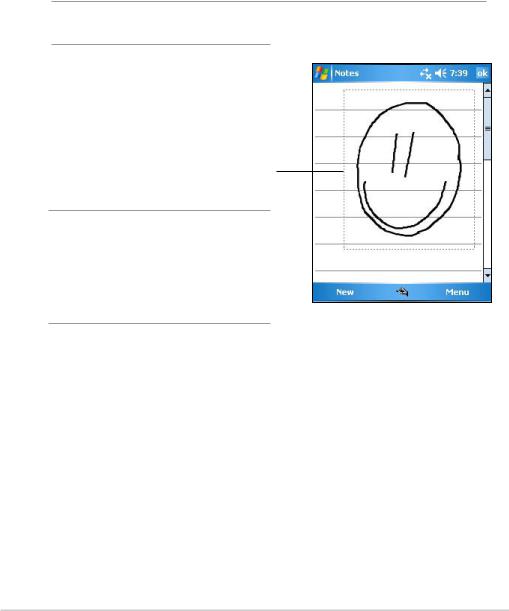
Drawing on the screen
You can draw on the screen in the same way that you write on the screen. The difference between writing and drawing on the screen is how you select items and how they can be edited. For example, selected drawings can be resized, while writing cannot.
To create a drawing:
1.Use the stylus to make a stroke that extends over three lines on the screen. A drawing box appears around the stroke.
NOTE If the drawing does not cross over three lines, the drawing box does not appear.
2.Continue drawing. If your subsequent strokes extend outside the box, you will notice that the drawing box expands to enclose all
the strokes.
The drawing box indicates the boundaries of the drawing
NOTE To easily work on or view your drawing, change the zoom level by tapping
Menu then Zoom and selecting your desired zoom.
To edit your drawing:
1.Tap and hold the stylus on the drawing until the selection handle appears. To select multiple drawings, drag to select the drawings you want.
2.Tap and hold the selected drawing, then tap an editing command on the pop-up menu or tap a command on the Menu.
3.Resize the drawing by and dragging a selection handle to your desired size.
2-8 |
Chapter 2 |
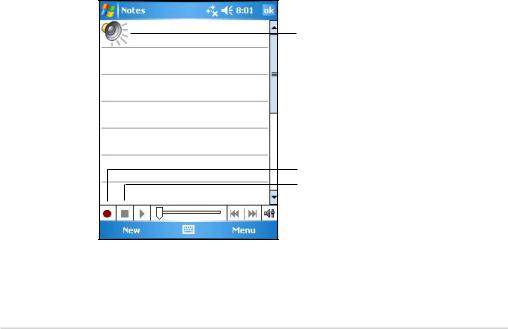
Recording a message
In any program where you can write or draw on the screen, you can also quickly capture thoughts, reminders, and phone numbers by recording a message. In Calendar, Tasks, and Contacts, you can include a recording in the Notes tab. In the Notes program, you can either create a standalone recording or include a recording in a written note. If you want to include the recording in a note, open the note first. In the Inbox program, you can add a recording to an e-mail message.
To create a recording:
1.Tap  > Programs > Notes.
> Programs > Notes.
2.Tap Menu from the Menu bar then select View Recording Toolbar to display the recording toolbar.
3.Hold your device with the microphone near your mouth or other source of sound.
4.Tap the Record button (red button) to begin recording. To stop recording, tap the Stop button. You will hear two beeps when you stop recording.
5.The new recording appears in the Notes list, or as an embedded icon. To play the recording, tap it from the list, or if embedded in a note, tap the speaker icon.
Indicates an embedded recording
Tap to begin recording
Tap to stop recording
Learn the basics |
2-9 |
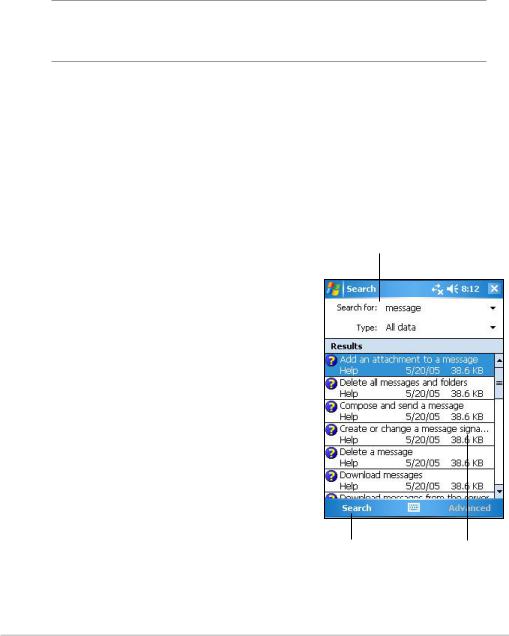
To change the recording format:
1.In the note list, tap Menu > Options.
2.Tap the Global Input Options link.
3.Tap the Options tab.
4.Tap the down arrow on the Voice recording format box to display the available options.
5.Select your desired format then tap OK when done.
NOTE Compared to other settings, the Pulse Code Modulation (PCM) provides slightly better sound quality but takes up 50 times more storage space tham Mobile Voice recordings.
Finding and organizing information
The Search and Help features on your device helps you quickly locate information.
Using the Search function
To search for information:
1.Tap  > Help > Search.
> Help > Search.
2.Enter the text that you want to find, select a data type, then tap Search to start the search. To quickly find information that is taking up space on your device, select Larger than 64 KB in Type.
To use the Help feature:
1.Tap  > Help.
> Help.
2.Tap a link to the topic that you wish to display.
Type a word to find
Tap to search for the word |
Topics found containing |
|
the searched word |
2-10 |
Chapter 2 |
